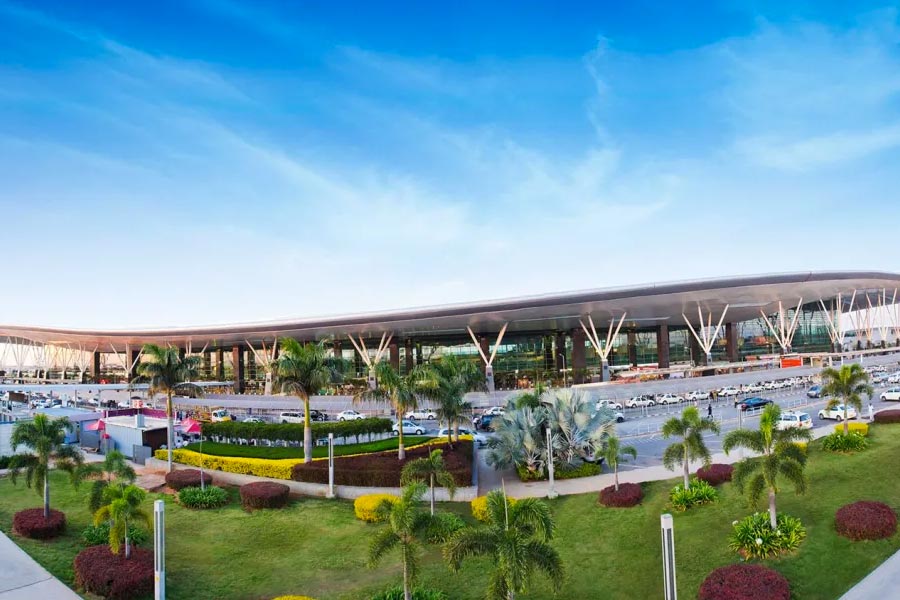Many trips to nurseries in Bengaluru as well as the field trips to Western Ghats yielded him about 153 species of native plants to grow on the 30-feet-high, 160-feet-wide (2 walls each of 80 feet) installation called ‘Tiger Wings’ aka ‘Patrick Wall’ at the Terminal 2 of the Kempegowda International Airport, said Patrick Blanc, a globally renowned botanist on Thursday.
The botanist is affiliated with the French National Centre for Scientific Research.
According to him, India, where he has been doing vertical garden projects for about 20 years now, usually offers 10 to 15 species to work with.
"It’s a pity that we have to choose from plants grown in tropical America, Africa and Southeast Asia. There is a need to nurture Indian species that can be grown in vertical gardens here, not many propagate them," Blanc told PTI.
In total, ‘Tiger Wings’ span 4,000 square feet and are home to over 15,000 plants across 153 species, added Hari Marar, Managing Director & CEO of Bangalore International Airport Ltd (BIAL), who had inaugurated the wall in the presence of Blanc on Thursday.
"I am not an expert on plants, but Patrick has promised that in three months when these 15,000 plants bloom, they’ll resemble a stretched out tiger on the wall," Marar told PTI later.
Explaining the process of creating the wall, Blanc said he has used specialised felt layers to create the soilless hydroponic wall garden.
"Felt layers create an environment where plants thrive," said Blanc, adding that the Bengaluru airport project is his biggest one in India so far.
Incidentally, Blanc has created a green wall at the Changi airport in Singapore too.
The soilless system used in the ‘Tiger Wing’ is different from the ones being adapted in the bell-shaped plant holders and beils (three-tiered plant holders that is a nod to traditional storage system of vegetable and fruits in Karnataka), both of which hang from the ceiling, green islands as well as the other walls that run around the various nooks and corners of the airport, said Sneha Subhedar, General Manager of Landscaping at BIAL.
"While we have been using a soil-less mixture consisting of coco peat among others, Blanc’s walls use specialised felt imported from Germany," added Subhedar, who walked the journalists through a guided tour of the airport’s green areas, including the forest belt adjacent to the airport that wraps itself around Terminal 2 and has nearly 700 fully grown trees that were uprooted for the building of the airport, which were later transplanted in an area of six acres.
The vertical garden is highly water-efficient, using a carefully designed irrigation system that delivers just the right amount of water to the plants through the felt layers, said Murali Mohan Bebartta, Senior Manager, Irrigation, BIAL, who had also accompanied the journalists during the guided tour.
The 15,000 plants used in the walls are grown in the nursery of BIAL, which was established in 2008 and which has in its stock nearly 200 species and more than a lakh plants, said Ashok Challapilli, Manager, Landscaping, BIAL, who is incharge of the nursery.
Later, while talking to PTI after the inauguration, Blanc further elaborated about his trademark felt-layers method.
"This method is more sustainable and replicates how plants grow on natural cliff faces or rock walls, where water and nutrients are minimal, but plants thrive in crevices. This approach allows for a diverse array of plant species to coexist in a compact vertical space, creating a thriving ecosystem that enhances air quality and contributes to a cooler, more pleasant environment," added Blanc.
Marar added that it cost about Rs 80 lakh to create the 4,000 square feet green wall, using Blanc's method.
"Good news is, this method requires almost no maintenance, nature will take care of itself," added Marar.
Except for the headline, this story has not been edited by The Telegraph Online staff and has been published from a syndicated feed.











